Introduction Top
Hello, my name is Slack. Here is a detailed guide how to play this certain build and it will also be explained why this build is the right for you, if you like stabbing people ofc. I love playing Abathur, because he is so troll and fun. Well also because he is a high skill level hero and can be played in different styles like many of the other heroes, but he is yet so different from the others. I have over 8 years of gaming MOBA games experience, yet I see more potential in HotS from the other games such as Heroes of Newerth, Dota 2, League of Legends, the Warcraft series and many more MOBA games. So if you came for suggestions or a good advice. I promise you your search is over, look no further, because Slack is here to help.
I am making this guide to bring both new players and experienced players together to help each other with finding the best builds, the best choices and why we make them to bring the most fun in the game. As of now, my own learning of the game has mostly come from watching professional players play the game from tournaments. Most of the professional players go with the Locust split push build with Abathur. As an exception I use the DakkeDak Build for stabbing people as a combo for other heroes with the capability to make a deadly combo. An example you might see ingame at the moment is Abathur and Illidan combo.
- Beginning Abathurs need to learn a whole new playstyle from the other heroes. By focusing on Symbiote performance and Nest placement, you can build the fundamental skills and map awareness that will help you progress forwards. These are necessary hallmarks before you start getting more aggressive with body placement and Locust play.
- Intermediate Abathurs may actually enjoy the enhanced map presence of a Symbiote-focused build, especially if you have heroes on you're team like Gazlowe or Zagara who can easily take merc camps. I prefer this playstyle so as to finish games with no deaths, ensuring that I'm able to contribute as frequently and thoroughly as possible.
I hope you liked the introduction to this Abathur Build, if you have anything you wanna follow my stream to have a chat or a good time -
Twitch.tv/slackgames
Also thanks to those who helped as inspiration for this Build.
- Xirias for the main ideas behind the Abilities.
- Redditor HMSChurchill for the knowledge of Toxic Nest ability.
- Jeppe, one of my good friends for having a good discussion about the main things behind Abathur.
- Landsbytossen, another one of my good friends I play HotS with. For making this idea come true by supporting it socially.
Pros and Cons - Abathur Top
Abathur is a hero unlike any other in the HotS universe. With a miniscule HP pool and abysmal damage, he is completely defined by his abilities. When playing Abathur, the game transforms into a miniature real-time strategy (RTS) game. With that in mind, solid Abathur players need a different skill set than other heroes, and a high level of familiarity with this game's heroes. We'll talk more about this in a moment, but first some quick pros and cons.
Pros
- Unique play styles based on build (Locust, Symbiote Damage, Symbiote Support)
- High skill cap
- Doesn't use mana, skills only rely on cooldown
- Incredible ability to save allies or snipe enemies near death
- Provides incredible map awareness
- Players focused on team synergy can really shine in this role
I recommend that as new player to HotS, you should focus on learning the Battlegrounds and different Heroes.
Cons
- High skill level
- Teamwork is a must - solo-queue can be a painful experience sometimes
- The first ten levels can be painful if the enemy team is pushing teamfights, as you'll be responsible for the constant 4v5 engagements
- Improperly assembling your talents can make you remarkably ineffective
For those who wanna go deeper into the abilities, capabilities and the opportunities with Abathur. Keep scrolling and thanks to some of my viewers for help making this guide.
Passive - Locust Strain Top
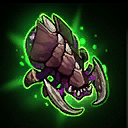
Every twenty seconds, Abathur spawns a Locust that travels to the nearest lane and attacks. When fully utilizing Abathur's kit, these little guys represent the most tactical risk/reward balance concerning body placement. We'll take a closer look at body placement later in the guide. Locusts are a great candidate for Symbiote given their disposability and high HP, especially when you invest some talents in them. In this guide, though, we'll be focusing on Symbiote play. If you spec into a Locust build, expect to be hopping around the map popping.
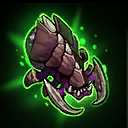
Locust Brood (syncing up your timing of placement to coincide with your passive Locust spawn), using
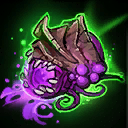
Locust Nest to throw the enemy team off of your body location and
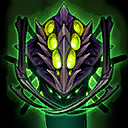
Evolve Monstrosity to split the enemy team's focus.
 Survival Instincts
Survival Instincts [Level 1] - Locusts increase their HP by 30%
 Assault Strain
Assault Strain [Level 13] - Locusts gain cleave (Aoe on basic attack) and explode on death
 Bombard Strain
Bombard Strain [Level 13] - Locusts gain a ranged attack
 Locust Brood
Locust Brood [Level 16] - Gain the ability to spawn a Nest near Abathur that hatches 3 Locusts.
 Locust Nest
Locust Nest [Level 20] - Activate to create a nest that periodically spawns Locusts. Only one Locust Nest can be active at a time.
Z - Deep Tunnel Top

Abathur lacks a mount in favor of this ability - after a short charge (can be interrupted by stuns but not damage) Abathur tunnels/teleports to any location on the map where he has vision. This will be your primary form of transportation during the game, allowing you to quickly reposition your body if you're in danger or have your locusts push a different lane. Deep Tunnel has a 30 second cooldown, so make your decisions carefully before you dig. By using Toxic Nests for vision, you can travel almost anywhere on the map, which is a great help if you're split-pushing or planning on taking a mercenary camp quickly, as you can Hearth back to base afterwards.
Q - Symbiote Top
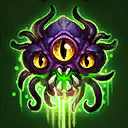
Symbiote is what we're going to focus on in this build, and one of the two core abilities that make Abathur so unique. This is a targeted ability that can be cast on any allied hero, building with ammunition (towers, forts & cores) minion or Mercenary. Please note you cannot target Grave Golems, Plant Terrors or summoned units! Symbiote is also what allows Abathur to control and contest multiple lanes, due to the global cast range and the fact that experience gained around the Symbiote is collected by the team rather than lost. This allows your team to support each other while you collect as much experience as possible to maintain momentum. Is your team contesting a tribute spawn? If they're team-fighting well, then soak experience in an abandoned lane - when your'e ahead, get more ahead.
Once cast, Abathur's body becomes immobile and you will infest your target, which opens up your second set of abilities. All abilities used while in Symbiote originate from your host (Stab & Spike Burst emanate from your host, Carapace targets your host). Symbiote has a 4 second cooldown that begins when you disengage with the R key - you can manually halt Symbiote at any time once cast. Each time you cast Symbiote, all of Abathur's abilities have are ready to be instantly cast - because of this, it is often wise to disengage and re-engage Symbiote to reset all your cooldowns. This especially effects Stab which starts with 2 or 3 (once talented) charges banked, and disengaging can be even more rewarding if you use

Sustained Carapace to keep your host shielded while you're on cooldown.
Be aware that you still take damage while this ability is being used, which is why body placement is so important with Abathur. Placing your body aggressively or defensively defines a huge part of his play styles.
Talents that effect Symbiote:
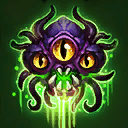 Adrenal Overload
Adrenal Overload [Level 4] - Symbiote host gains 25% increased Attack Speed.
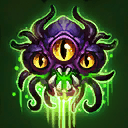 Hivemind
Hivemind [Level 20] - Casting Symbiote creates an additional Symbiote on a nearby allied Hero that mimics the commands of the first.
W - Toxic Nest Top
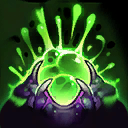
Toxic Nest is Abathur's greatest power for maintaining map awareness during a game. These tiny proximity mines take a moment to activate, but once they do, they grant vision. Nests exist on a timer, and while there's no limit to the number of simultaneous nests on the map, they will expire in time. This is your vision ward, only you don't need to be nearby to place it. And it explodes.
Do be aware that Nests do not grant vision on cloaked units or Creep Tumors. Always confirm if the enemy team has cloaked heroes for you to contend with. If they do, use Nests at points where you expect the enemy cloaked heroes to try and approach you for the kill, it reveals them for 4 seconds if hit. Ideally, place them close enough to buildings, so if they trip the mine, they'll soak some tower fire, then Deep Tunnel to safety.
You begin with 3 charges (can be increased to 5) of Toxic Nest, which, for most players, is more than adequate due to the 12 seconds it takes to replenish a charge being easily passed during Symbiote infestation. The range is substantial, but requires a talent to make it global. In this build, we won't be taking the global cast-range talent (or any nest talents for that matter), so your body placement will dictate what range of the map you can keep vision on. Use it in frequently used paths, on objectives, mercenary camps and in bushes to give your team the information they need to make good decisions and stay alive.
Since you'll be spending most of your time using Symbiote, it is easy to lose track of how many charges of Toxic Nest you have available. Get in the habit of checking that number during those few seconds you are disengaged, and while you're waiting for Symbiote's cooldown to pass. Drop any available nests in key locations on the map while you wait and assess your next Symbiote target. The faster you get at making these decisions, the better informed your team is.
An incredible way to help your team with nests is to use them to clear enemy minions and mercenaries pushing a lane - especially if it allows your team to continue a separate push or engagement. A few nests can do solid damage if placed underneath enemy knights or siege mercenaries. Keep an eye out for these pushes and put out the fire yourself if you can. As an added bonus, you do harvest EXP for minions and mercenaries killed by your nests, but only if the nest damage is what "last hits" them. [Thanks to Redditor HMSChurchill for the reminder about this use of nests]
The damage from Toxic Nest isn't game-changing, but you can use it for some solid disruption, by soaking some auto attacks during teamfights or placing them under enemy players trying to capture objectives. It's a rare thing to secure a kill using a nest, but when it happens, it is glorious. If you take Vile Nest (which I generally don't recommend for this build due to the necessity of
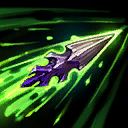 Needlespine
Needlespine for Stab builds to be viable), you can use Nests to help your allies escape by placing them on a path your team will likely cross while disengaging.
Talents that effect Toxic Nest:
-
 Envenomed Nest [Level 1] - Nests deal 50% extra damage over 3 seconds
Envenomed Nest [Level 1] - Nests deal 50% extra damage over 3 seconds
-
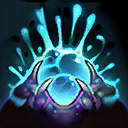 Ballistospores [Level 4] - Makes Toxic Nest cast range global, increases duration by 20%
Ballistospores [Level 4] - Makes Toxic Nest cast range global, increases duration by 20%
-
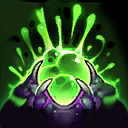 Prolific Dispersal [Level 4] - Nest charges increased from 3 to 5, reduce codlin by 2 seconds
Prolific Dispersal [Level 4] - Nest charges increased from 3 to 5, reduce codlin by 2 seconds
-
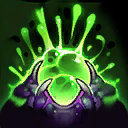 Vile Nest - [Level 7] Nests slow down enemies by 40% for 4 seconds
Vile Nest - [Level 7] Nests slow down enemies by 40% for 4 seconds
(Symbiote ability) Q - Stab Top
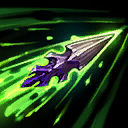
This skillshot is on a three second cooldown and is going to be your primary source of damage through a game. The projectile fired has a distinct speed, so practice constantly! Being able to lead your shots will ensure a higher hit rate given the substantial cooldown. Getting used to the two stab ranges (pre- and post-
 Needlespine
Needlespine) will also help you conserve stabs that won't hit, though it's often worth throwing them out to help zone fleeing enemies.
Stab begins the game with 2 charges, which allows you to fire a reasonable number of them before the cooldown becomes prohibitive. Note that the cooldown is greater than the cooldown from Symbiote, so it is often helpful to disengage Symbiote and re-cast to get all your stacks of Stab back, especially late game.
Stab damage is always defined by Abathur's level and talents and has no correlate to what unit you're infesting - you can do incredible amounts of damage with this ability while infesting minions, mercenaries and buildings, so keep an eye open for opportunities. Punish enemy heroes trying to clear minion waves at low health, and soften enemy heroes as they travel to make for more favorable engagements for the rest of your team.
Talents that effect Stab:
 Needlespine
Needlespine [Level 7] - Increase Stab range & damage by 20%
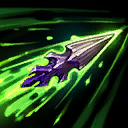 Spatial Efficiency
Spatial Efficiency [Level 13] - Increase Stab charges from 2 to 3
(Symbiote Ability) W - Spike Burst Top
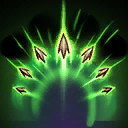 Spike Burst
Spike Burst is an AoE nova that emanates from Symbiote's host. The 6 second cooldown is notably longer than the cooldown of Symbiote, just like Stab, so disengaging and re-casting Symbiote will allow you additional AoE damage. You can also decrease cooldown with
Pressurized Glands
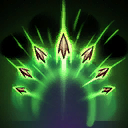
.
Spike Burst is helpful when you have multiple targets in close proximity, like any AoE ability is. This makes it excellent at clearning minion waves and merc camps. Interestingly, the range of Spike Burst increases when infesting the Core, unlike Stab which remains static. Alone, the ability is helpful for burst damage but becomes much more versatile if you employ talents that effect it.
Talents that effect Spike Burst:
 Pressurized Glands
Pressurized Glands [Level 1] - Increase range of Spike Burst by 25%, reduce cooldown by 1 second.
 Soma Transference
Soma Transference [Level 13 - Symbiote's Spike Burst heals the host for each enemy Hero hit.
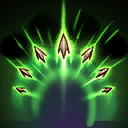 Envenomed Spikes
Envenomed Spikes [Level 16] - Spike Burst slows enemies by 40% for 2 seconds
(Symbiote Ability) E - Carapace Top
 Carapace
Carapace provides a shield for your host that lasts for 8 seconds, with the ability on a 12 second cooldown. With certain talents, this becomes your main support ability during Symbiote. In general, the moment you cast Symbiote you will immediately activate Carapace due to it's long cooldown and, if selected, the heal over time effect.
Correct use of Carapace is directly related to good use of
 Symbiote
Symbiote in general - you identify a target on your team that is at risk and boost it's health. While the use of Stab will dictate your Symbiote casting on an offensive level, helping your allies escape alive with Carapace is also incredibly important. When fully talented, it provides a shield, heal over time and move-speed increase on an allied hero - an incredible ability. However, be aware that the move-speed increase and healing effects are compromised the moment you disengage your Symbiote.
With the introduction of
 Networked Carapace
Networked Carapace, you could
Symbiote

a Mercenary and apply a shield and heal to all nearby non-heroic units, and with
 Sustained Carapace
Sustained Carapace, disengage after using your offensive abilities and do it again. Serious lane-pushing potential.
Talents that effect Carapace:
 Regenerative Microbes
Regenerative Microbes - [Level 1] - Carapace gains a small heal per second effect
 Sustained Carapace
Sustained Carapace - [Level 4] - Carapace lasts 50% longer and persists after Symbiote ends.
 Networked Carapace
Networked Carapace - [Level 7] - Using Symbiote on a Minion or Mercenary also applies Carapce to all nearby Minions and Mercenaries.
 Adrenaline Boost
Adrenaline Boost - [Level 16] - Carapace increases the move-speed of host by 40% for 3 seconds
(Heroic Ability) R - Ultimate Evolution Top

To the casual player, this ability is a large part of what garners Abathur the difficulty label "Very Hard". When you cast Ultimate Evolution, Abathur's body disappears and an egg appears right next to the target. After a few seconds, the egg hatches as a clone of the targeted hero that you fully control lasting 20 seconds. The clone has all non-heroic abilities and traits of the targeted hero but none of the talents - remember this before you clone a Sgt. Hammer and realize you don't have Hover Mode!
Again, you do not get access to your target's heroic ability.
Ultimate Evolution is what allows your team to finally engage 5v5, and you'll have to choose who to clone based on your team composition, needs of the engagement, and your familiarity with your partner's heroes. The only thing you can prepare for in advance is in knowing as many heroes as possible, so I strongly recommend Abathur players sink in a few games as each hero using the Free Hero rotations. You never want to be in a game where you aren't comfortable with any of the heroes you could clone, you'll severely handicap your team.
When your clone is still an egg, it is vulnerable to enemy attacks. When possible, feel out your team's movements and prep the clone before the engagement begins to avoid taking significant damage before the egg hatches. This will also allow you to position yourself accordingly as well (getting Warriors to the front of team movements or staying off the front lines as a ranged assassin).
After the timer ends or your clone is killed, Abathur reappears where he originally was. Please note that after a patch in early December 2014, the cooldown timer for this ability now begins when your clone dies or the timer expires. As of January 2015, your clone provides the enemy team experience points when killed. These two considerations are important as you'll have to decide if feeding the enemy team a little bonus EXP is worth lowering your cooldown. In general, you'll want to soak as much damage as you can without dying, but always sacrifice the clone if it means saving a teammate.
After a patch on March 24, 2015, Ultimate Evolution clones now gain 20% Ability Power, 20% Attack Damage and 10% Movement speed bonuses over their targets, which makes it much more compelling, though in this build, the split pushing possibility of Evolve Monstrosity somewhat trumps it. Both cool-down and duration were decreased by ten seconds each as well.
Talents that effect Ultimate Evolution:
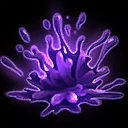 Volatile Mutation
Volatile Mutation [Level 16] - Clones deal AoE damage every 3 seconds and when they die
 Evolutionary Link
Evolutionary Link [Level 20] - As long as your clone is alive, the original target gains a shield that refreshes every 5 seconds.
G - Ping (COMMUNICATION IS IMPORTANT) Top
If you press G, you can click on any target and a context-sensitive message will appear for your team. If you click on a mercenary camp, a ping will appear on the minimap at their location along with the message that Abathur wants to take the mercenary camp. If you press G and click on a building, it will say ping and say you want to defend that building. If you click on an enemy hero, the team will get a message that you want to target that hero. The system also works for entering the mines, capturing a shrine or turning in dubloons - just ping what you want your team to do. If you click anywhere else, the minimap will ping, but no message will be displayed, so you better tell your team what you're aiming for.
Where this gets even more powerful is if you hit G, then click and drag. You'll see your four other communication options - Danger, Retreat, On My Way and Assist Me. These are great, fast ways to communicate to your team if you see opportunities or dangers. Also be aware that you can quickly send a Retreat ping using the V key.
Your body is almost never in danger as Abathur, so you owe it to your team to help them as much as you can - let them know where danger is, where opportunities are, and when objectives are up. More than any other hero, you can keep an eye on the respawn timers on mercenary camps, and alert your team (also tell them "our knights up in 15") to make sure you're in optimal position for maintaining or gaining map control.
I can't emphasize this enough. Ping is part of Abathur's kit. You have to use it, you have to communicate, or you'll be letting your team down. And I hope it doesn't need to be said, but don't Ping spam. Don't be that guy. No one likes that guy. Be concise, direct and proactive.
Playstyle - Body and Nest placement Top
Now that we finally have all that out of the way, let's get to the three major focuses of Abathur play in this build.
Body placement is the first fundamental we'll look at. Your goals with body placement are:
- Minimize death - your goal is to go zero deaths every game. By not dying, you won't have downtime that you can't Symbiote your teammates. You need to be alive and present during the entire match.
- Maximize Locust utility - your locusts have a timed life, which means they can only run so far down a lane. If you're too far back, too conservatively located, your locusts won't live long enough to make it to the front lines.
- Maximize map awareness - since we aren't taking Ballistospores for global Nest placement, it's important that you place your body where you can place Nests in the most helpful places.
As soon as the game begins, you'll be moving your body to one of your forward forts so your locusts can push your enemy's forward forts. When choosing a lane, first consider how safe each forward fort is - your best choices are forts that have fewer ways to access it. After you've picked a fort, either position yourself right next to the fort (so any player trying to dive on you will be in range of as many damage-dealing buildings as possible) or in a nook (place where enemy heroes would have to fight through buildings to get access to you.
After you've picked an opening position where your body will be safe, drop some nests to provide vision. You can focus nest placement in the grass if your enemies utilize that form of cover regularly or just outside of your lanes so you can see when an enemy is preparing for a gank. After you've secured vision in locations like these, you can branch out to objectives, placing nests by Mercenary camps, Tribute spawn points, the Dragon Shrines, Dubloon camps, etc. Frequently used footpaths are great candidates too, so you can track enemy movement in the jungle. Does the enemy team have cloaked heroes? Drop some nests near your body to expose them so the towers can hit them - bonus points if you catch them early enough to Deep Tunnel to safety.
As the game progresses, you'll need to move your body to make sure your locusts aren't being wasted. For this conservative build, you'll likely jump between forward forts. Always pick a fort where you can stay safe (has the most intact buildings), and if there are multiple choices, pick the lane where the enemies still have a forward fort for your locusts to attack. Once all your forward forts are down, you'll retreat to the main base and select the best defended lane the enemy has, so your locusts can still contribute. By late game, your locusts may be a bit of an afterthought, as they won't reach too far. Again, in this build, this is a missed opportunity, but we're focusing on other parts of your game.
Playstyle Top
![]()


Quick Comment () View Comments
You need to log in before commenting.